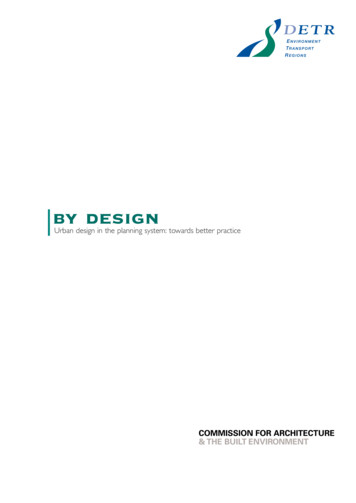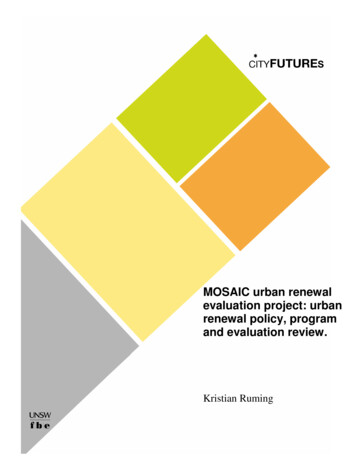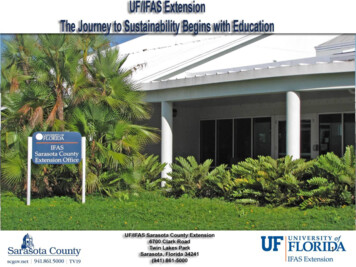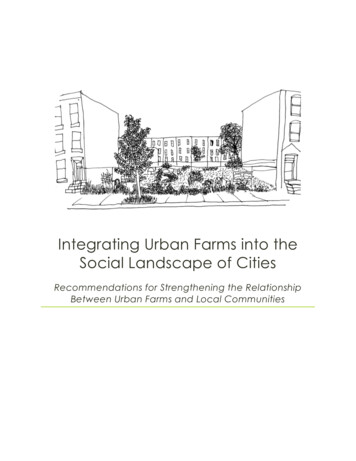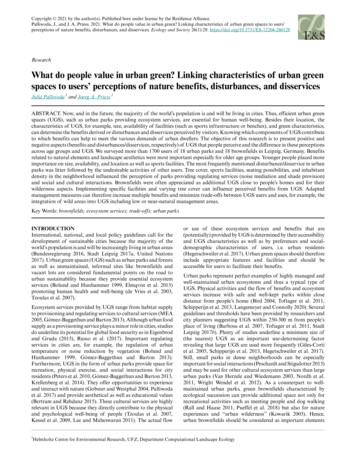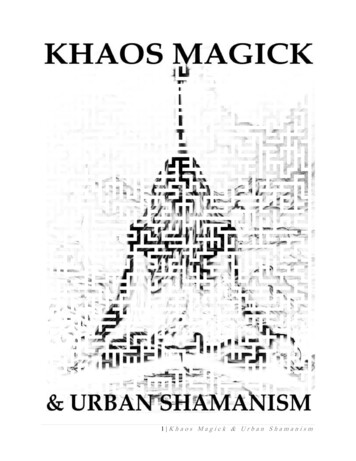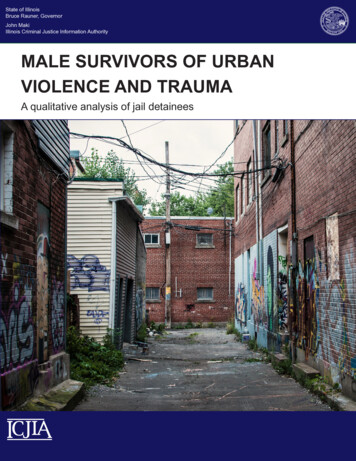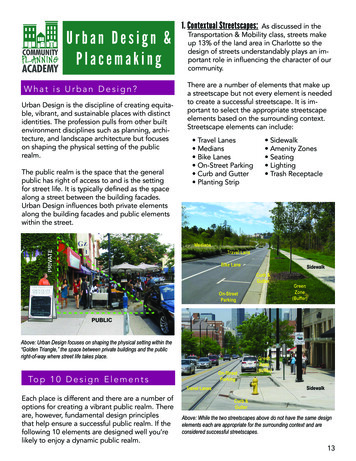
Transcription
Urban Design &PlacemakingWhat is Urban Design?Urban Design is the discipline of creating equitable, vibrant, and sustainable places with distinctidentities. The profession pulls from other builtenvironment disciplines such as planning, architecture, and landscape architecture but focuseson shaping the physical setting of the publicrealm.The public realm is the space that the generalpublic has right of access to and is the settingfor street life. It is typically defined as the spacealong a street between the building facades.Urban Design influences both private elementsalong the building facades and public elementswithin the street.1. Contextual Streetscapes:As discussed in theTransportation & Mobility class, streets makeup 13% of the land area in Charlotte so thedesign of streets understandably plays an important role in influencing the character of ourcommunity.There are a number of elements that make upa streetscape but not every element is neededto create a successful streetscape. It is important to select the appropriate streetscapeelements based on the surrounding context.Streetscape elements can include: Travel Lanes Medians Bike Lanes On-Street Parking Curb and Gutter Planting Strip Sidewalk Amenity Zones Seating Lighting Trash ReceptacleAbove: Urban Design focuses on shaping the physical setting within the“Golden Triangle,” the space between private buildings and the publicright-of-way where street life takes place.To p 1 0 D e s i g n E l e m e n t sEach place is different and there are a number ofoptions for creating a vibrant public realm. Thereare, however, fundamental design principlesthat help ensure a successful public realm. If thefollowing 10 elements are designed well you’relikely to enjoy a dynamic public realm.Above: While the two streetscapes above do not have the same designelements each are appropriate for the surrounding context and areconsidered successful streetscapes.13
In order to determine what elements are needed for a streetscape professionals must evaluate the surrounding context: What is the street’s role in terms of transportation? Is it a collector street intendedto carry heavy loads of commuter traffic? Oris it a neighborhood street that carries lesstraffic? What land uses are along the street? What constraints are present? Is thereenough room to include all the desiredstreetscape elements?and stairs - anything that allows pedestrians tomove from a private space to the public realm.Connections from surrounding buildings andparking are almost always encouraged. Connections from private residences to the publicrealm, however, should be designed to providea sufficient level of privacy for residents.2. Safe SidewalksSidewalks are a vital element for a vibrant public realm because they enable pedestrians towalk to and through the space. It is consideredbest practice to provide some separation between travels lanes and the sidewalk in order tooffer pedestrians a sense of safety. The widthof sidewalks, however, can vary depending onthe type of place they serve:Above: While a sidewalk connection from the residence to thepublic realm is provided the fence prohibits residents from using theconnection. The fence should be replaced with a functional gate. Neighborhood Streets: Avg. 5’ sidewalks Mixed-Use Streets: Avg. 6 - 8’ sidewalks Urban Commercial Streets: 8’ sidewalks Outdoor Dining: Requires 12’ sidewalksAbove: The stairway provides both a connection to the public realmand a degree of separation from it which offers residences as sense ofprivacy.Above: In many situations, it is ideal to provide a planting strip and treesin order to buffer the sidewalk from adjacent vehicular traffic.3. Frequent ConnectionsConnections from surrounding uses to thepublic realm are also important because, similar to sidewalks, they help bring pedestriansto the public space. Connections can include anumber of elements such as sidewalks, gates,144. Active Building EdgesIn order to have a vibrant public realm, building edges need to be active rather than blank.An active building edge includes elements thatprovide visual interest and offer a connectionbetween activity inside the building and thepublic realm. Some common elements used toactivate a building edge include transparentwindows and frequent building entrances.
Above: The transparent windows and frequent entrances create anactive building edge which helps enliven the public realm and create aninteresting place to walk.ly an issue because the scale of their designprovides an inherent rhythm or level of interest along a block. Buildings with a larger form(tall building height and long building width),however, can be problematic if they are notdesigned to incorporate frequent elements ofinterest along the ground floor. For example,a tall, block-long building with no windows,entrances or architectural details along the firstfloor will feel intrusive and domineering fromthe public realm. If, however, the same firstfloor is treated with various elements of interestthe form will feel more inviting and approachable from the public realm.5. Prominent Building EntrancesAs described, frequent building entrances canhelp activate a building edge and provideregular connections between the private spaceinside a building and the public realm. Oneprominent building entrance per building isalso important because it helps pedestriansknow where to first enter the building. Prominent building entrances also contributes to theunique character of a public space.Above: Pedestrians can easily find this building entrance which islocated at a prominent corner and is emphasized by a large staircaseand monumental street numbers.6. Appropriate Building FormThe form of buildings (height, width and overall massing) plays an important role in enhancing the public realm. Buildings with a small tomedium form (low to medium building heightand moderate building width) are not usual-Above: The ground floor of the yellow building is lined with opaquecorrugated metal which makes this large form feel uninviting andoppressive from the sidewalk. In comparison, the ground floor of thebrick building incorporates a lot of windows, regular entrances, andvarious materials for architectural interest. The ground floor treatment ofthe large brick building is more inviting and approachable.7. Proper Building PlacementWhere a building is placed on a lot, either setback from the street or built close to the street,15
impacts the public realm. Buildings that arebuilt close to the street help frame the publicrealm, and a well-framed space frequently feelssafe, active and interesting. Buildings setbackfrom the street can contribute to a vibrant public realm but active uses such as outdoor diningor a parklet need to be incorporated into thesetback. The public realm is hampered when abuilding is setback from the street and inactiveuses like a parking lot are located in the setback.Above: On-street parking is provided in front of the main building.Additional parking is provided in the surface parking lots located to theside and rear of the building.Above: The two new buildings being constructed on the north side ofthe street are built close to the pedestrian realm. The existing buildingin between the construction sites is setback from the road and a parkinglot is located between the building and public realm. The parking lotdetracts from the pedestrian experience.8. Thoughtful TransitionsSimilar to building form, transitions betweenbuildings along a block can either impact orenhance the public realm. Thoughtful transitions such as a step down in height between amid-rise and low-rise building allow two different forms to harmoniously occupy the sameblock. An abrupt change in building forms,however, can make pedestrians feel like something is out of place or context.9. Well-Placed ParkingParking is an important amenity for urbancommunities. However, thoughtful design ofthe type of parking and location of parking isimportant to protect a vibrant public realm.On-street parking, when feasible, providesconvenient short-term parking for storefronts16and creates a buffer between vehicular traffic in the travel lanes and pedestrians on thesidewalk. On-street parking, however, is notalways feasible or sufficient. On-site parkingcan include surface parking lots or structuredparking decks. In order to protect the publicrealm and ensure it’s occupied by active uses,surface parking lots should be located to therear or side of buildings. Structured parkingis expensive to construct so it is typically onlyfeasible with a minimum amount of density.When structured parking is feasible, it shouldbe located within the site and wrapped withactive uses. Structured parking, like blankbuilding edges, should not be adjacent to thepublic realm.10. Opportune Open SpaceOpen space within the public realm may include small formalized plazas or landscapedparklets. These spaces are usually created by
recessed building facades or at the corner oflots. They offer pedestrians an opportunity tosit and rest or chat with others, enjoy a bite toeat, or interact with public art or an installation.Left and above: The outdoor seating area and public fountain fill in spacenot utilized by a building footprint. Both spaces offer a unique elementof interest for the public realm and provide residents an opportunity tointeract with other people or their public space.Placemaking: What & How?Placemaking is both an overarching idea anda hands-on approach for improving a neighborhood, city, or region. Placemaking inspirespeople to collectively reimagine or reinvent alocal asset or space in order to create something that is unique, inspiring and reflective ofthe community’s identity. Interactive artworkGamesStreet seatsGuerrilla gardening The options are endless.If you have a placemaking idea or want to learnmore about the topic please visit the CharlottePlacemaking Hub, an online one-stop-shop forplacemaking references and /default.aspxAnyone can participate in placemaking: Neighborhood Organizations Local Students Advocacy Groups Local Government Urbanists (People who love cities) Planners KidsAnd there are so many types placemaking: Temporary events Parklets Little Free Libraries Building/Pavement murals Neighborhood bus stops Neighborhood bike racks Painted intersectionsAbove: The Charlotte Placemaking Hub is an amazing online resourcefor anyone interested in creating unique places for their neighborhood.17
built close to the street help frame the public realm, and a well-framed space frequently feels safe, active and interesting. Buildings setback from the street can contribute to a vibrant pub- lic realm but active uses such as outdoor dining or a parklet need to be incorporated into the setback. The public realm is hampered when a building is setback from the street and inactive uses like a .



